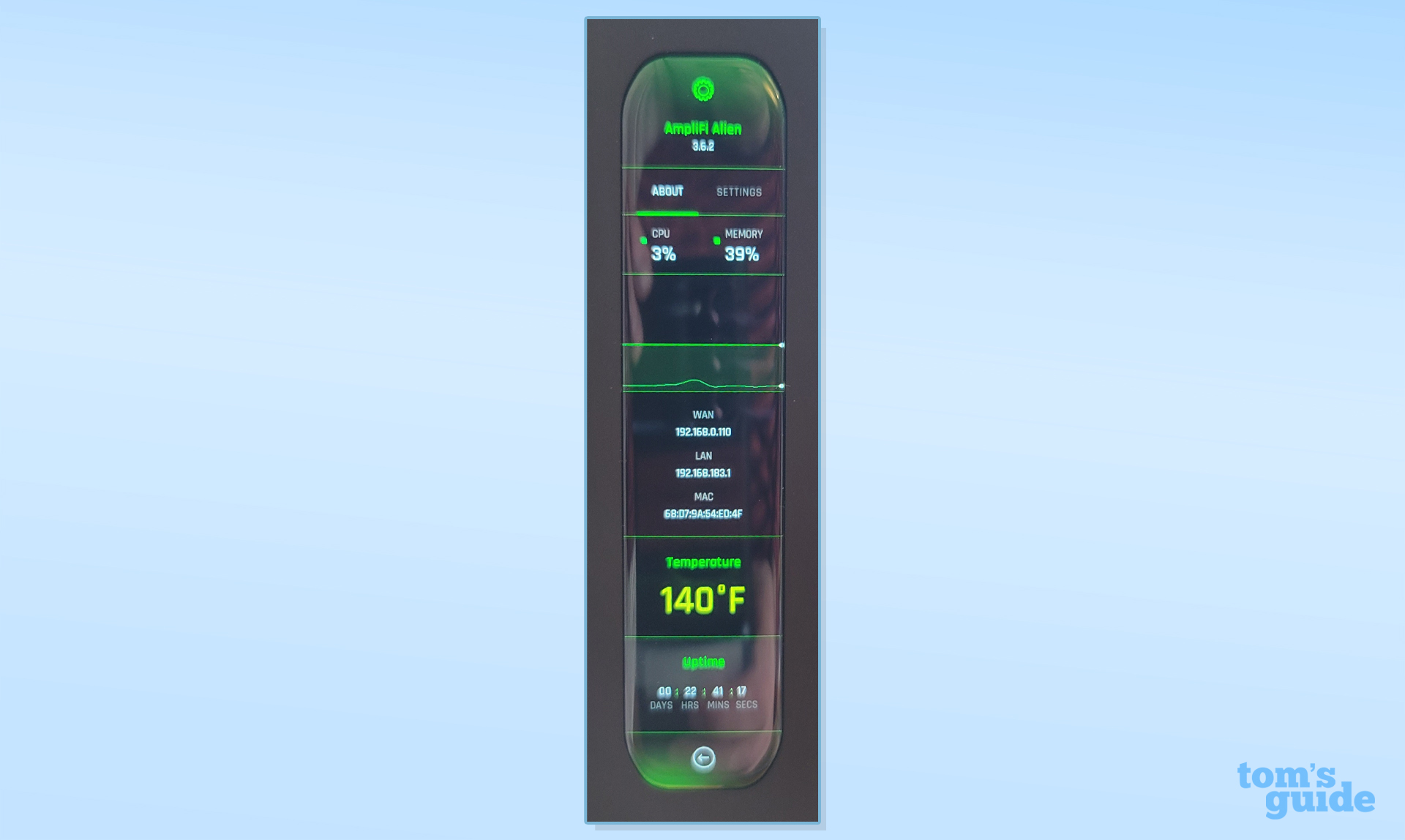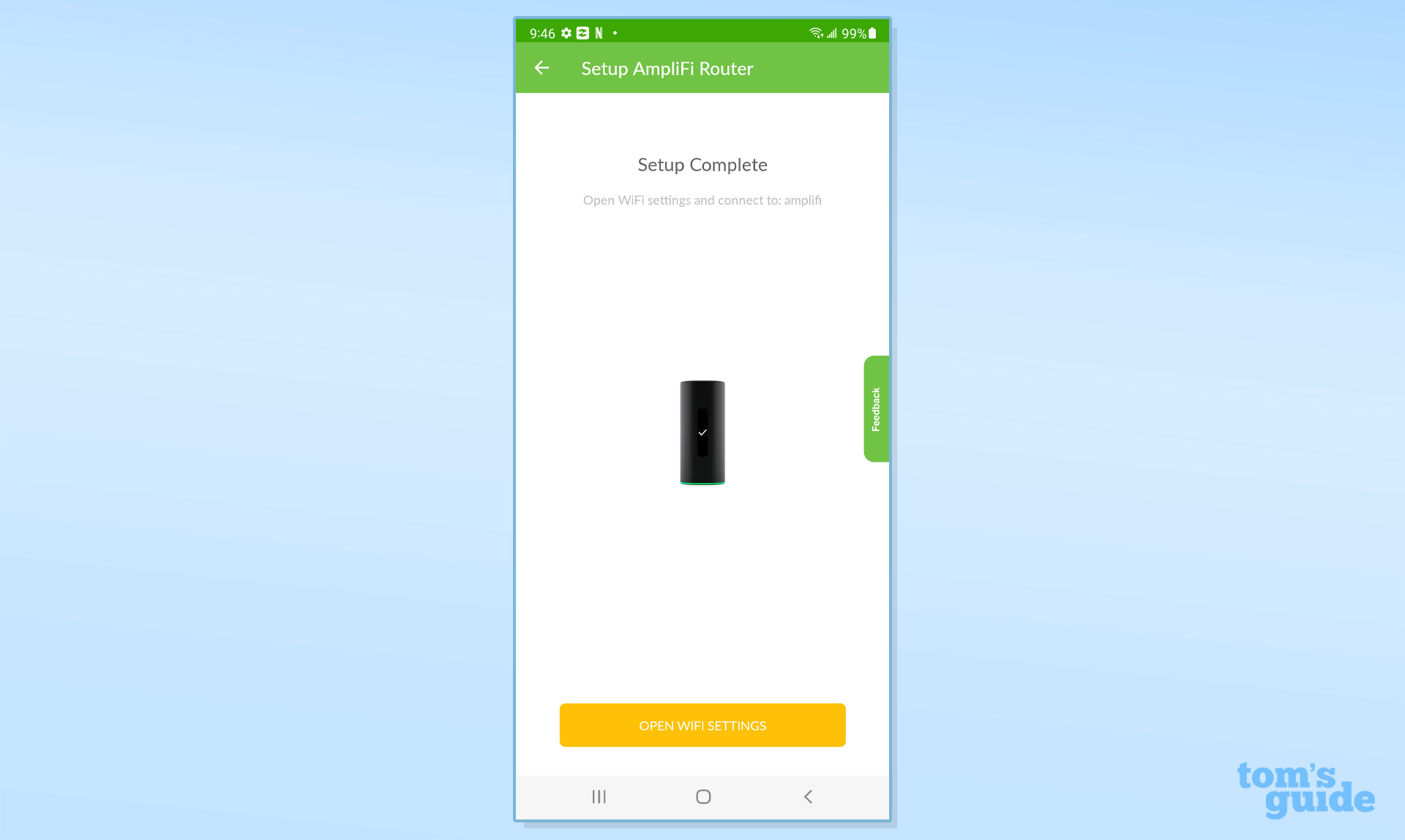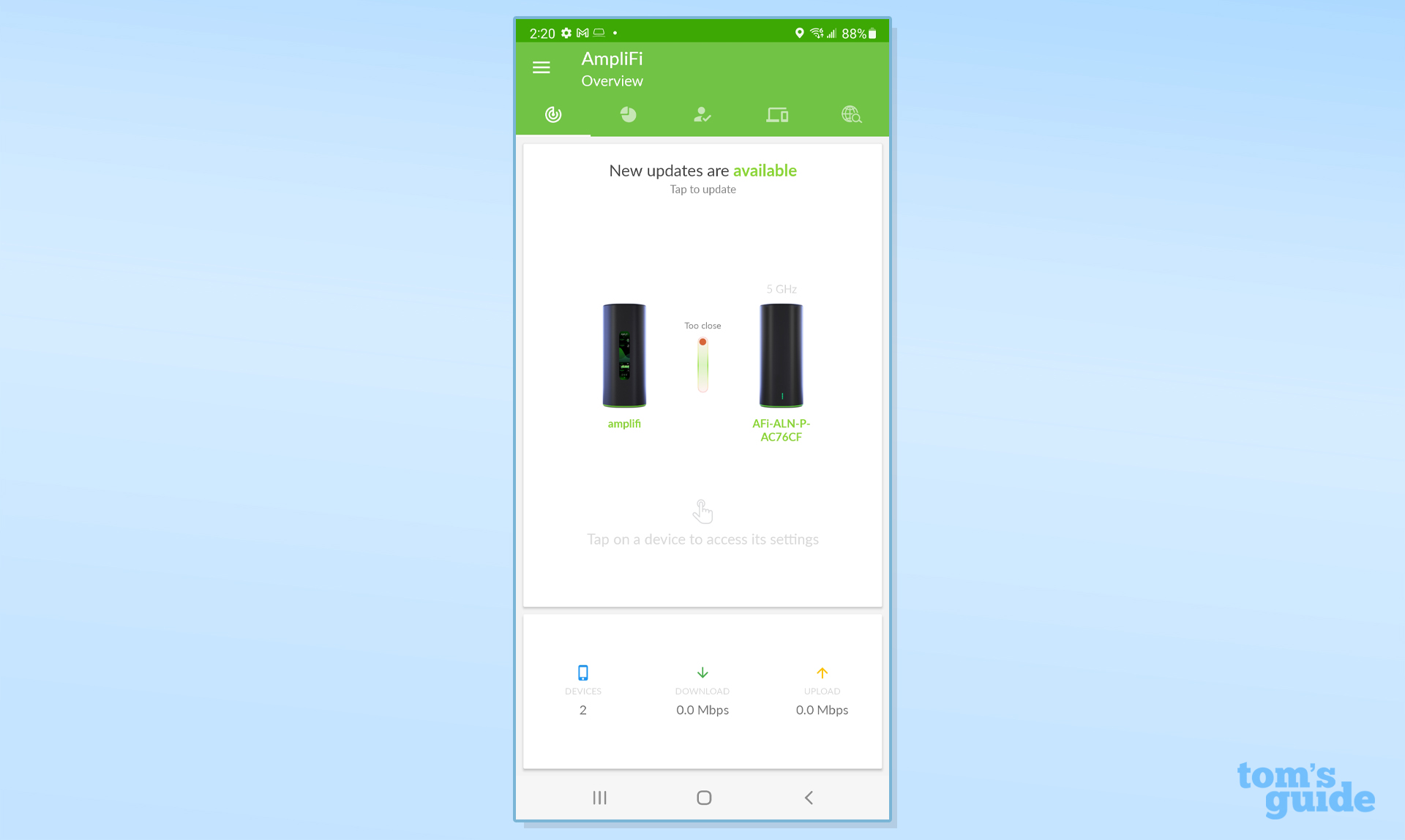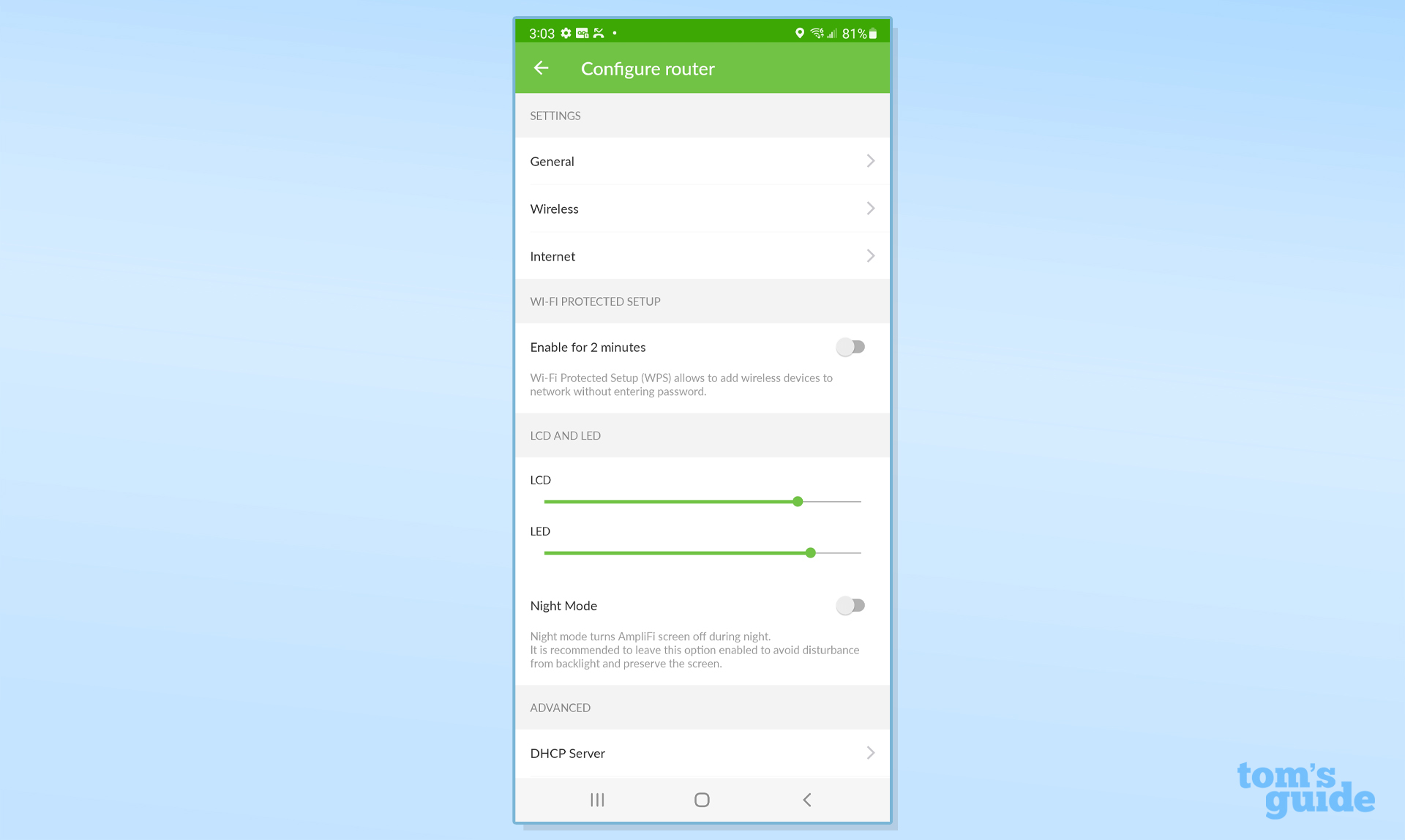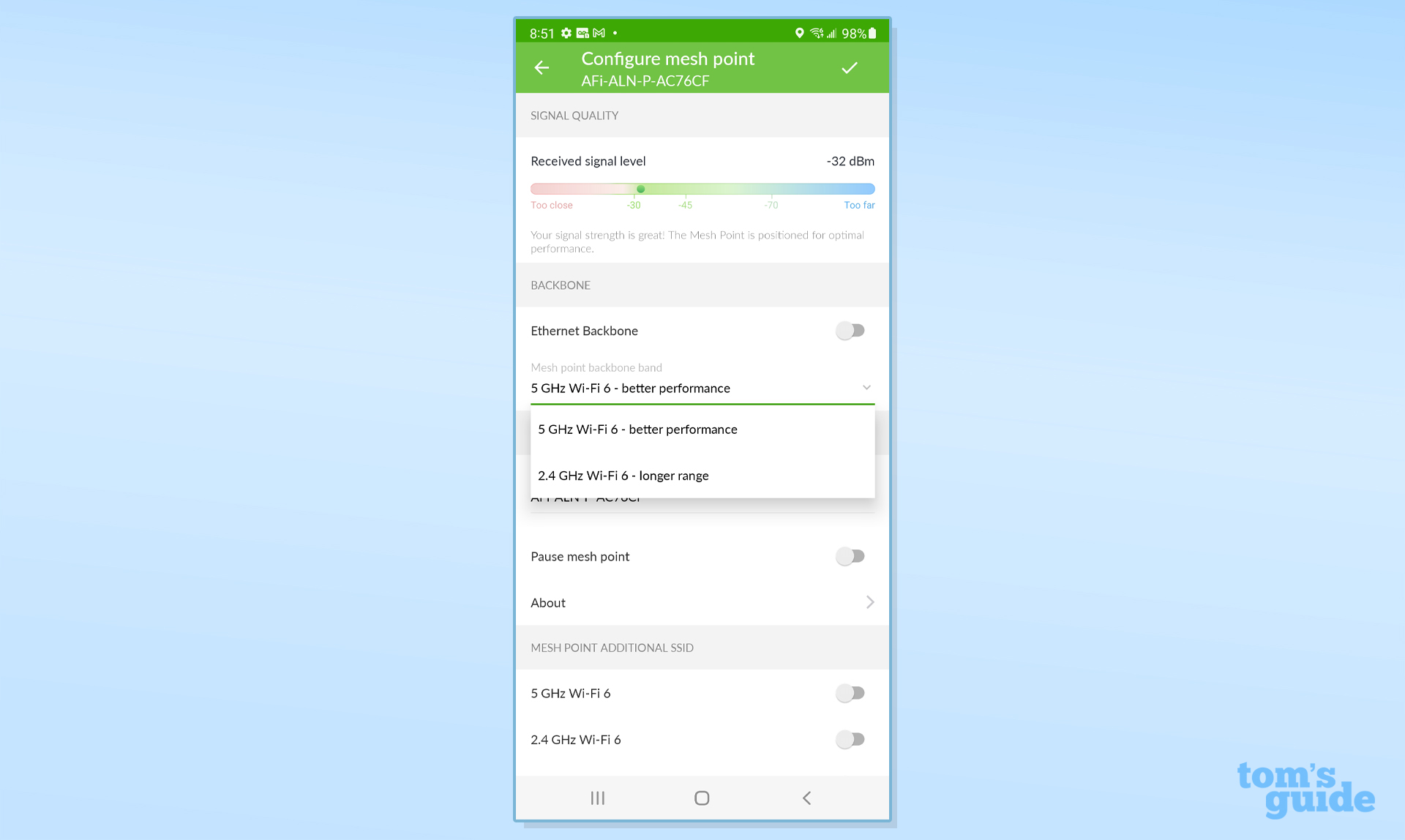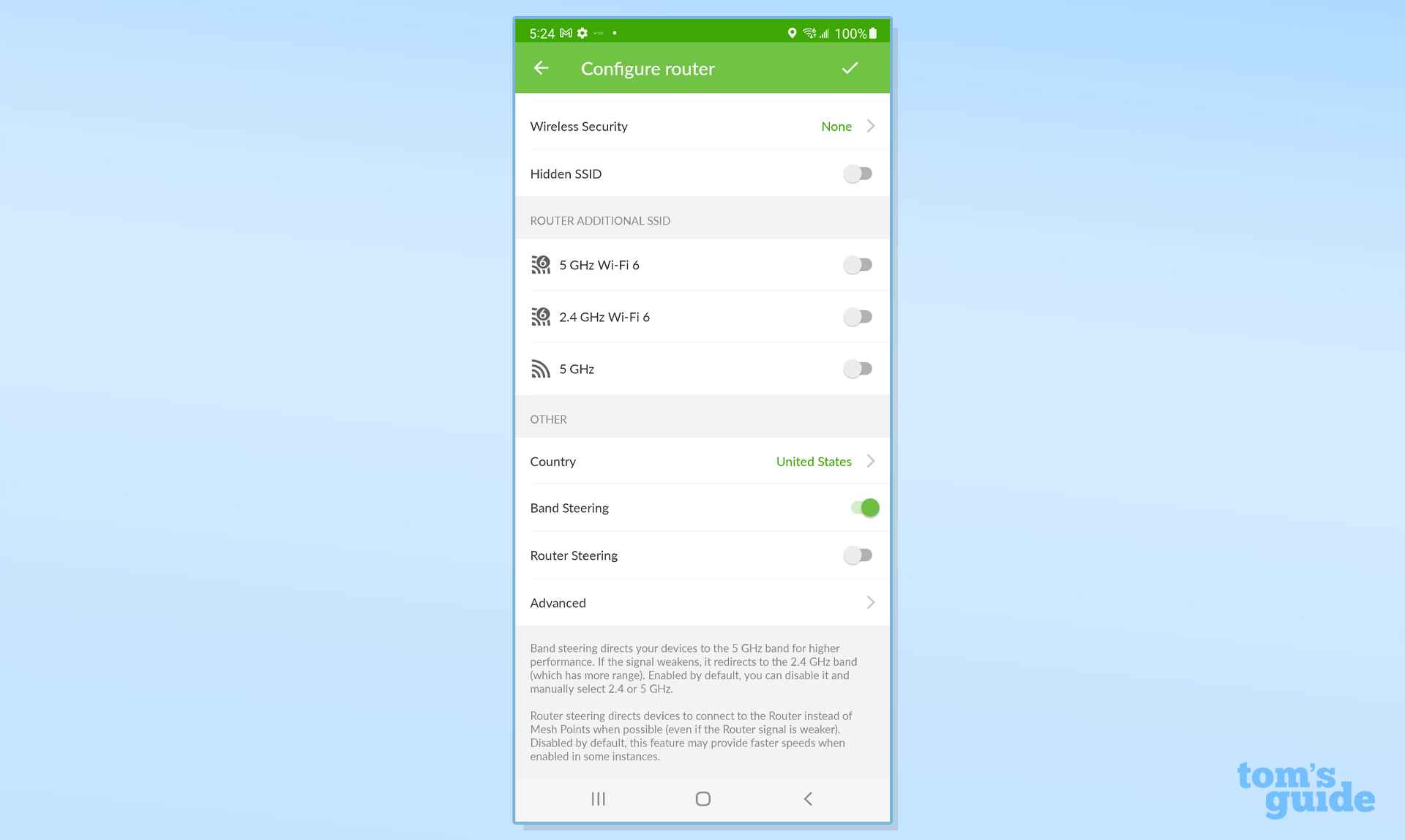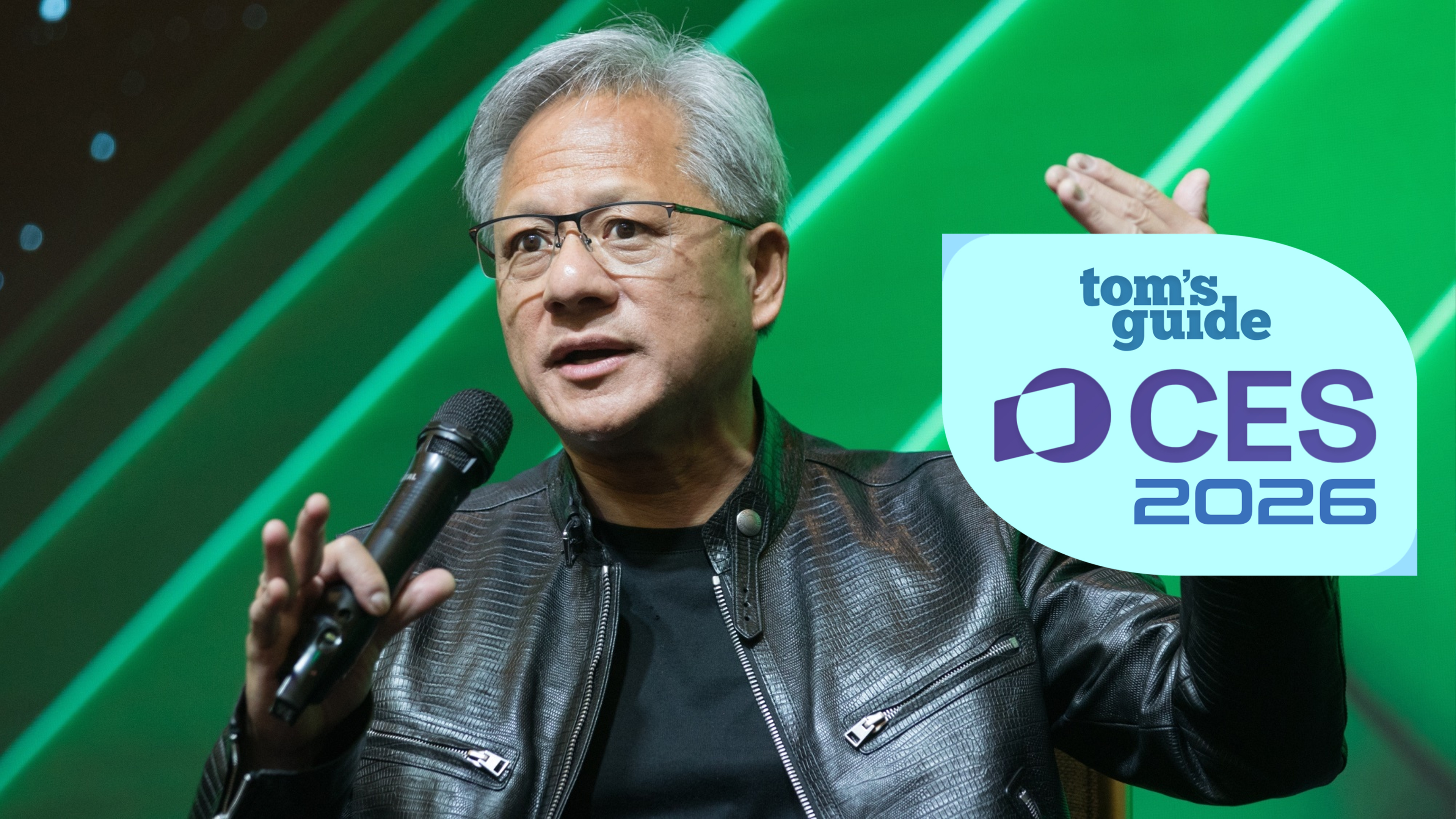Tom's Guide Verdict
It might not offer the fastest data speeds but the Amplifi Alien has something that other mesh kits don’t: a touch screen that not only shows what’s going on inside the network but lets you make changes. It costs as much as the class-leading Orbi RBK852 and lacks some creature comforts, like a USB port but the AmpliFi Alien is for those who want insights into their network at a glance.
Pros
- +
Information touch screen
- +
Customization from router
- +
Doesn’t need external AC adapter
- +
Fast setup
Cons
- -
Expensive
- -
No USB ports for attaching storage
- -
Router requires fan
Why you can trust Tom's Guide
Wi-Fi Spec: AX7700
Number of Antennas/Removable: 12/No
Ports: Router: 1 WAN/4 LAN gigabit per second; Satellite: 1 WAN/1 LAN
Processor/Memory/Storage: 2GHz quad-core/1GB/256MB
Wi-Fi chip: Qualcomm IPQ8074
Peak 802.11ac performance: 636.2 Mbps (at 15 feet)
Range: 100 feet
Size: 4.3 x 4.3 x 9.8 inches
Estimated Annual Electricity Cost: $35.60
Being the fastest router counts for a lot but the AmpliFi Alien mesh kit impresses with a cool information screen that shows the network’s vital details and allows changes to be made on the fly. One of the fastest mesh kits to set up, the AmpliFi Alien has excellent range but falls short on overall performance. It has a cooling fan but lacks USB ports for adding storage.
At $700 for the two-pack — the same price as the class-leading Orbi RBK852 — the AmpliFi Alien’s ace in the hole is its ability to telegraph operational information without using the router’s app. Our AmpliFi Alien review will help you decide if it is one of the best mesh routers and whether or not its unique design and screen are worth the premium.
AmpliFi Alien review: Pricing and availability
AmpliFi’s triband Alien mesh kit consists of a router and a matched pre-paired MeshPoint satellite that is rated to fill 6,000 square feet. Its $700 price is on a par with the Orbi RBK852 two pack. A standalone Alien router, which can be paired with another router, can be had for $379 but the company doesn’t sell extra nodes.
AmpliFi Alien review: Design
Like something out of “2001: A Space Odyssey,” the Ubiquiti AmpliFi Alien picks up where the AmpliFi HD router left off. The Alien mesh kit has black cylindrical towers that measure 4.3 x 4.3 x 9.8 inches — tiny compared to other mesh kits, like the Arris Surfboard Max Pro and the Asus ZenWiFi AX8. Unfortunately, AmpliFi doesn’t sell mounting hardware but third-parties do for under $30 or you can make your own with a 3-D printer.
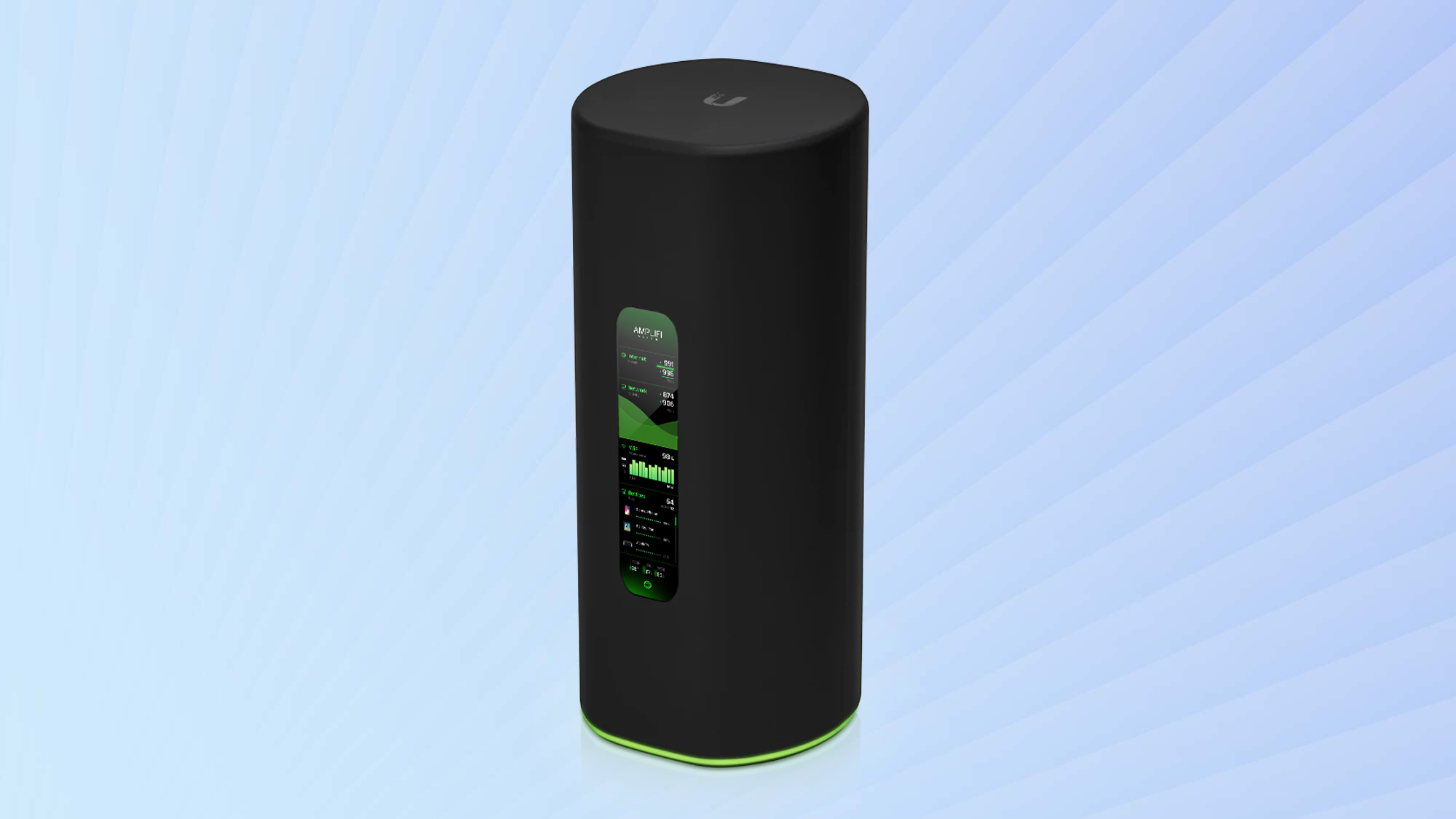
The center of attention for the Alien router is its info screen. At 4.7-inches , it’s long and narrow versus the AmpliFi HD’s round screen. At a resolution of 1268 x 274 pixels, it shows a lot of data in a green and white on black format. Unlike other routers that only have annoying blinking lights, the AmpliFi Alien can show anything from current network devices and internet status to the processor and memory loads.
My favorite is the running graph of throughput that shows network activity. It’s the only router I’ve seen that measures its internal temperature, displays it and shows if its fan is running. It frequently registered upwards of 140 degrees Fahrenheit internally but the case never got higher than 110 degrees Fahrenheit.
The Alien’s screen not only shows the name of your ISP but the date and time, although this can be replaced by the company’s logo. Since it’s touch sensitive, the router’s display can do things that other routers can only dream of. This includes running an internet speed test and updating the system’s firmware. Sure, you can do these things from the app or a connected browser, but the AmpliFi Alien lets you do it from the router.
Get instant access to breaking news, the hottest reviews, great deals and helpful tips.
If this is too much, the night mode can shut down the screen and LED ring independently on a daily schedule. At any time, it’s easy to reduce the screen and the LED ring’s brightness. By contrast, the MeshPoint node only has the LED ring.
Both have soft rubber feet and a cut-out in the back for routing the WAN connection and power cord. Happily, the AmpliFi Alien doesn’t have a bulky external AC adapter.
Unlike other routers that only have annoying blinking lights, the AmpliFi Alien can show anything from current network devices and internet status to the processor and memory loads.
Powered by a Qualcomm IPQ8074 Wi-Fi chipset, the system uses a 2GHz quad-core processor to keep up with data traffic. It’s got 1GB of RAM and 256MB of flash storage space for firmware and network settings. Based on the 802.11AX protocol, it creates a tri-band network that uses the 2.4GHz band (up to 1.148 Gbps) as well as a low-bandwidth 5GHz channel (at 1.733 Gbps) and a high-bandwidth 5GHz channel (at 4.804 Gbps). The Alien kit lacks the ability to tap into the Wi-Fi 6e’s 6GHz band, however, and carries an AX7700 rating.
It’s easy to change from using the 5 GHz or 2.4 GHz band for the back-haul channel that shuttles data from the satellites to the router. If your home has Ethernet cables, you can use them to turn the satellite into a wired access point.

While the router has a WAN input and four downstream LAN ports, the MeshPoint satellite has one Ethernet port. All support gigabit per second transfers but none can handle 2.5 Gbps inputs.
AmpliFi Alien review: Performance
Using Ixia’s IxChariot networking benchmark to simulate 10 data-hungry users and a Samsung Galaxy Book Pro as a connected client, the AmpliFi Alien was reliable but fell short of the best. After a week of daily use, the two-piece kit came close to filling my 3,500 square foot house but left several small dead zones in the basement.
With 15-feet (4.5 meters) between the router and the receiving Galaxy Book Pro, the benchmark recorded 636.2 Mbps of throughput. That should be fine for most families but fell short compared to the Netgear Orbi RBK852 (at 883.6 Mbps), the SURFboard mAX Pro (820.3 Mbps) or the Asus ZenWiFi AX8 (701.0 Mbps). Still it’s 18 percent more bandwidth than the TP-Link X20’s 522.1 Mbps. All are well off the 1.232 Gbps pace set by the Wi-Fi 6E-based Asus Zen ET8.
At 50-feet (about 15 meters), the AmpliFi Alien’s throughput dropped off to 177.4 Mbps. That’s in the middle between the resurgent Deco X20’s 255.4 Mbps and the Asus ZenWiFi AX8’s 136.0 Mbps and the Orbi RBK 852’s 124.5 Mbps.
Oddly, at a distance of 75-feet (roughly 23 meters), the Alien’s data flow jumped to 199.1 Mbps. That’s a lot better than the Asus ZenWiFi AX8’s 6.3 Mbps, the Arris Surfboard Max Pro’s 16.6Mbps, the Deco X20’s 85.9 Mbps and the Orbi RBK852’s 112.7 Mbps. The Alien router delivered 22.1 Mbps at 90-feet, where the Orbi RBK8532 and Arris Surfboard Max Pro were offline.The Deco X20 was the winner here with 51.1 Mbps available.
The AmpliFi Alien had a reach of 100-feet, versus 95-feet for the Deco X20, 85-feet for the Orbi RBK852 and 80-feet for the Surfboard Max Pro.
With the ability to deliver 571.8 Mbps across a 20-foot room and through a wall, the AmpliFi Alien was behind the Orbi RBK852’s 782.9Mbps. That said, it was more than three times the 150.5 Mbps that the Deco X20 made available on the same test.
With the AmpliFi Alien’s MeshPoint satellite set up a floor above the router and our receiving system 40-feet away, the system was able to grab 429.5 Mbps. By contrast, the Orbi RBK852 managed to move nearly double that at 782.9 Mbps. The Deco X20 delivered a middle of the road 294.5 Mbps.
It easily passed my informal network-saturation test where I watched 4K video on my Galaxy Tab S7 tablet and HD videos on my Lenovo ThinkPad T470 laptop, while an HP Dragonfly notebook played an internet radio station as I downloaded data on my Note 20 phone. While this was going on, a MacBook Air moved data on to and off of a networked RAID storage array. None of the audio or video streams were interrupted or had any freeze ups or skips.
While it was working, the router used 14.8 watts of power, versus the satellite’s 14.2 watts. If you pay the national average of 14 cents per kilowatt-hour of electricity, the kit might cost $35.60 a year in power bills, a good deal more than the Asus ZenWiFi AX8’s estimated $18.60 a year.
AmpliFi Alien review: Setup
The Alien mesh kit is a quick starter but can only be set up using its Android or iOS AmpliFi WiFi app. The app is bright and detailed but only works in portrait mode.
AmpliFi Alien is nothing short of the fastest route to a two-piece mesh network.
After plugging the router into my cable modem and an AC outlet, I started the app up on my Samsung Galaxy Note 20 phone. Like the typical Netgear Orbi setup, the AmpliFi router and MeshPoint satellite are pre-matched with each other at the factory. Happily, there’s no need to create an account with the company.
I turned on Geolocation, Bluetooth, Wi-Fi and agreed to the company’s legal mumbo-jumbo. At this point, the router’s LED ring was glowing green.
Next, I added a network name and password for my new LAN. It gave me the option of also using this for the administrative password, which I declined.
The router took half a minute to do its configuration and emitted a short contemplative tune to show it was done.
It took all of two minutes to go from the sealed box to a working LAN. The app showed that “Everything is Great” and yielded 200Mbps from my broadband connection.
Next up: add the MeshPoint satellite. With it in a room a floor above, I tapped on the icon for it. Less than a minute later it was incorporated into the mesh network.
AmpliFi Alien is nothing short of the fastest route to a two-piece mesh network.
AmpliFi Alien review: Configuration
Like other recent mesh kits, the AmpliFi Alien allows configuration with the app or a connected browser. The app’s main page showed the signal strength for the MeshPoint node, the number of clients and the data flow to and from them.
At the top is an alert for new firmware. Tap to install it. There are also icons for performance (including overall throughput), the guest network and the ability to use AmpliFi’s unique Teleport app that secures communications using a Virtual Private Network (VPN). I used it with my iPad from nearly 100 miles from my home, although its speed dropped from over 200Mbps to 15.4Mbps.
In addition to a page that shows what devices are connected and their current speed, the app has a Diagnose page that interrogates the WAN connection for things like the IP address and DNS Connection. Those with Ubiquiti accounts can remotely manage the network.
If you tap on the satellite’s icon you end up on a very useful configuration page. Its signal strength meter can help get the best placement for the MeshPoint node.
I dug deeper and was able to change the band the network’s back-haul channel uses for communications from the satellite to the router, choosing the higher performing 5GHz instead of the 2.4 GHz band for greater range. There’s a place to pause the data.
While other mesh products offer more in-depth configuration choices via a connected browser, the AmpliFi Alien has fewer options. The Settings screen has several customization choices in a long narrow column but I had to set the zoom to 33 percent to take them all in. The choices range from automatically switching between 2.4- and 5 GHz back-haul bands to setting up 160MHz wide data channels to establishing Quality of Service (QOS) priorities.
The System Info page shows who’s online. There’s detail about their speeds and signal strength. Click on the Topology tab and a network map appears.
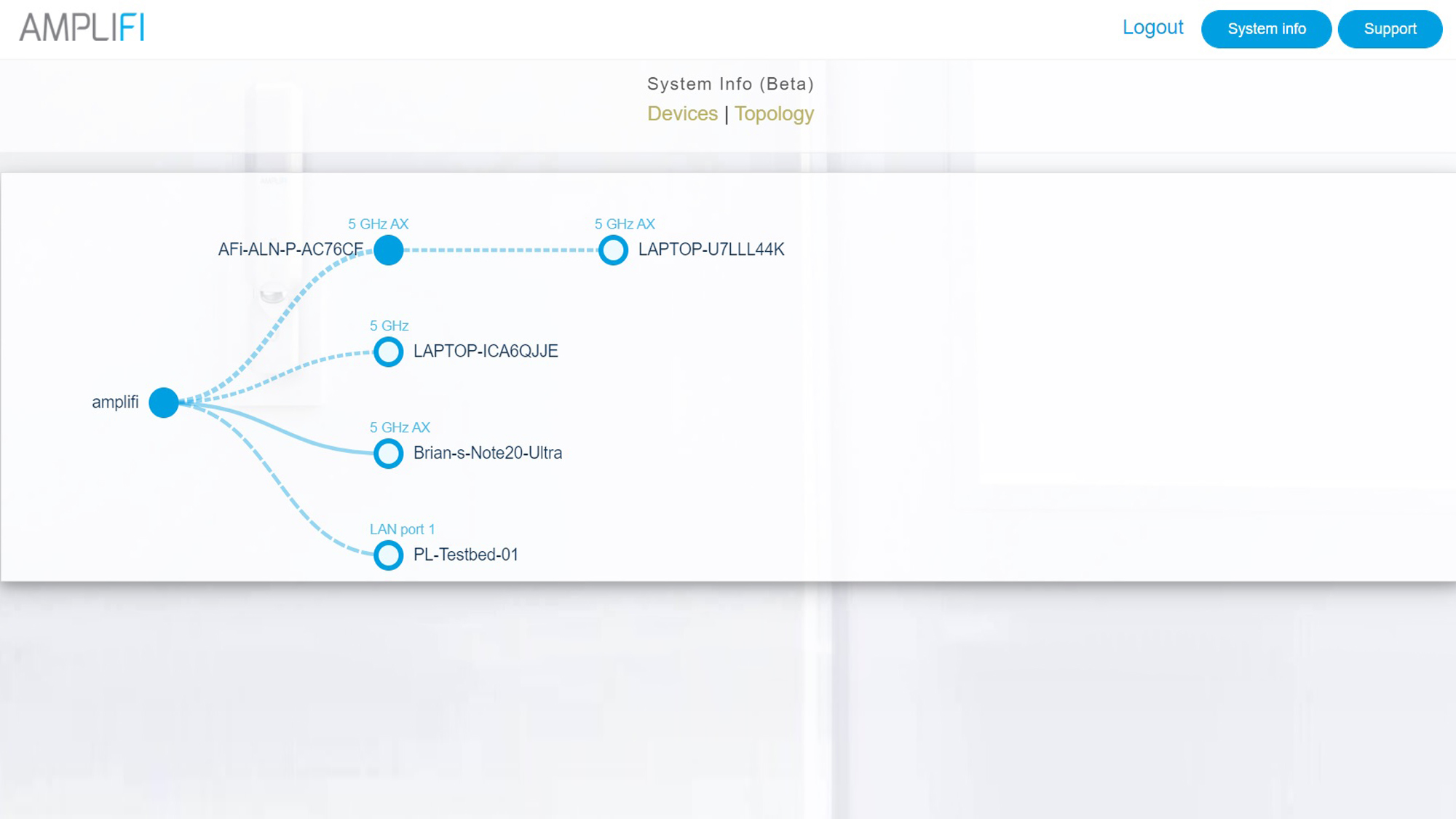
While it can set up band steering to push data over the 2.4- or 5GHz bands, unlike other Wi-Fi 6 devices, the AmpliFi Alien lacks full customization by doing without things like Fragmentation threshold and the use of long or short Preamble. It has no extra security software, like Netgear’s Armor, Asus’s AIProtection or TP-Link’s HomeShield.
The hardware comes with a one-year warranty along with lifetime tech support, which is a step down from Asus’s two years of protection. However, it’s better than Netgear’s 90-day tech support policy.
While the mesh kit lacks a printable manual, there’s lots of individual articles on how to do specific things, like improving Wi-Fi stability and reconnecting MeshPoints.
AmpliFi Alien review: Verdict
If you like to know what’s going on inside your network, forget about getting the fastest Wi-Fi 6 router because the AmpliFi Alien’s data screen not only shows performance parameters but allows you to make changes. It costs the same as the higher-performing Orbi RBK852 but offers greater range. All in all, it’s the mesh kit to get if you care more about seeing the network’s operation details than getting every last megabit per second of throughput.
Brian Nadel is a freelance writer and editor who specializes in technology reporting and reviewing. He works out of the suburban New York City area and has covered topics from nuclear power plants and Wi-Fi routers to cars and tablets. The former editor-in-chief of Mobile Computing and Communications, Nadel is the recipient of the TransPacific Writing Award.


